<< Previous | Displaying results 2851-2900 of 6769 for "" | Next >>
A Polish policeman checks the papers of a Jewish resident of the Warsaw ghetto. Warsaw, Poland, February 1941.
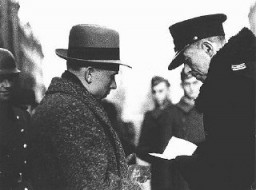
A Jewish man attempts to make a living by playing music on a gramophone, which he wheels around in an old baby carriage. Warsaw ghetto, Poland, wartime.
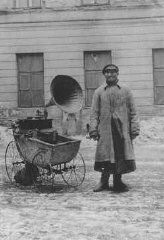
A German policeman interrogates a Jewish man accused of trying to smuggle a loaf of bread into the Warsaw ghetto. Warsaw, Poland, 1942-1943.
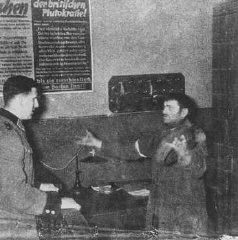
False identification card which Vladka Meed had used from 1940–42 on the Aryan side of Warsaw, smuggling arms to Jewish fighters and helping Jews escape from the ghetto.
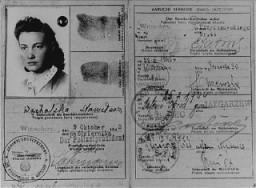
Jews rounded up during the Warsaw ghetto uprising are forced to march to the assembly point for deportation. Warsaw, Poland, April or May 1943.
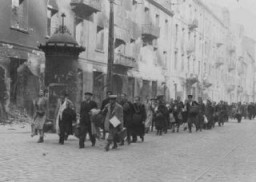
A German motorcycle unit advances through the Bydgoszcz region during the invasion of Poland. September 18, 1939.
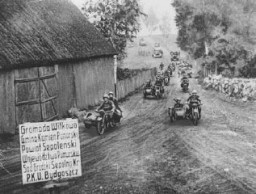
View of the entrance to a marketplace reduced to rubble as a result of a German aerial attack. Warsaw, Poland, September 1939.
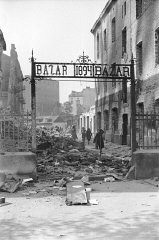
Poles walk among the ruins of besieged Warsaw. This photograph documenting war destruction was taken by Julien Bryan (1899-1974), a documentary filmmaker who filmed and photographed the everyday life and culture of individuals and communities in various countries around the globe.
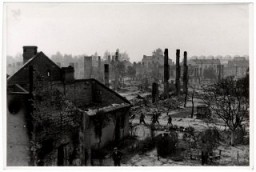
German troops parade through Warsaw after the German invasion of Poland. Warsaw, Poland, September 28-30, 1939.
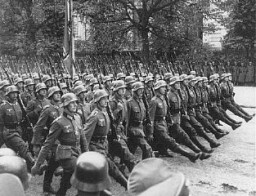
Adolf Hitler (lower right) gives Nazi salute as he reviews victorious German troops. Warsaw, Poland, October 5, 1939.
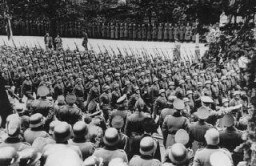
German soldiers parade in Pilsudski Square. Warsaw, Poland, October 4, 1939.
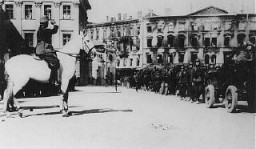
A German postcard showing the entrance to the Lodz ghetto. The sign reads "Jewish residential area—entry forbidden." Signs forbidding entrance to Poles and Germans were posted at all entrances to the ghetto. Lodz, Poland, 1940–1941.
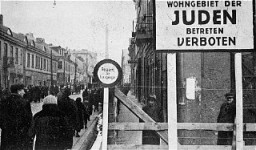
An official visit of Heinrich Himmler to the Lodz ghetto. Mordechai Chaim Rumkowski, head of the Jewish council, greets the Nazi officials. Lodz, Poland, June 5, 1941.
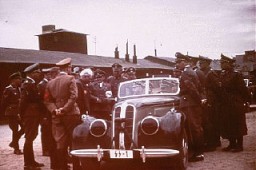
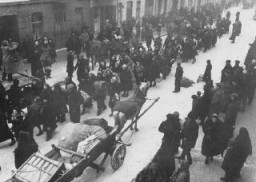
Jews carrying their possessions during deportation to the Chelmno killing center. Most of the people seen here had previously been deported to Lodz from central Europe. Lodz, Poland, January–April 1942.
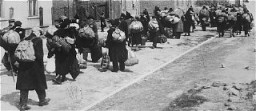
German police raid a vandalized Jewish home in the Lodz ghetto. Lodz, Poland, ca. 1942.
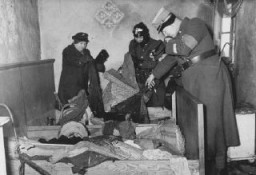
Jews from the Lodz ghetto are forced to transfer to a narrow-gauge railroad at Kolo during deportation to the Chelmno killing center. Kolo, Poland, probably 1942.
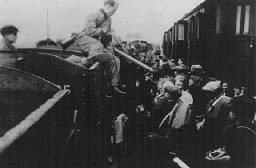
The motto of Mordechai Chaim Rumkowski, chairman of the Lodz ghetto Jewish council: "Our only path [to survival] is [through] work." Lodz, Poland, wartime.
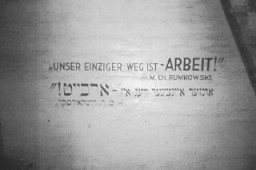
Jewish women at forced labor in a sewing workshop in the Lodz ghetto. Lodz, Poland, between 1940 and 1944.
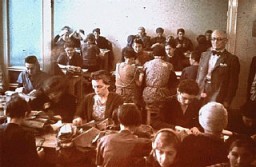
"Gypsy camp" area in the Lodz ghetto. Roma (Gypsies) were confined in a segregated block of buildings. Poland, 1941–44.
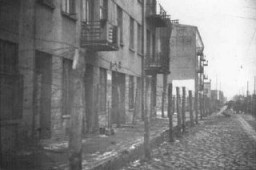
Deportation of Jews from the Lodz ghetto. Poland, August 1944.
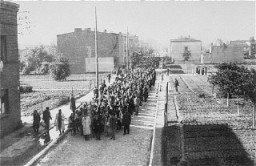
Soon after liberation, surviving children of the Auschwitz camp walk out of the children's barracks. Poland, after January 27, 1945.
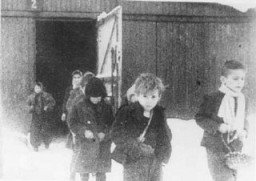
A survivor of the Bergen-Belsen camp, photographed soon after liberation. Bergen-Belsen, Germany, after April 12, 1945.
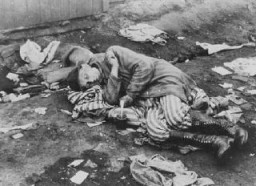
Emaciated survivors of the Buchenwald concentration camp soon after the liberation of the camp. Germany, after April 11, 1945.
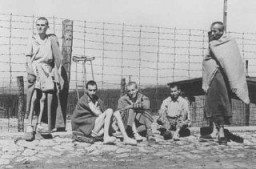
Piles of corpses, soon after the liberation of the Mauthausen camp. Austria, after May 5, 1945.
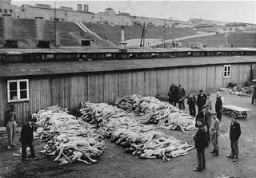
Soon after liberation, a camp survivor receives medical care. Bergen-Belsen, Germany, after April 15, 1945.
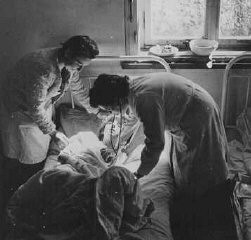
Soon after liberation, a British woman helps a camp survivor try on shoes. Bergen-Belsen, Germany, after May 1945.
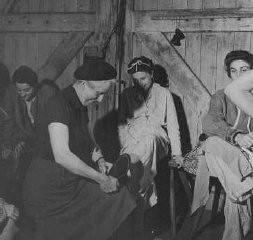
Jewish female survivors at a convalescent home. Sweden, 1946.
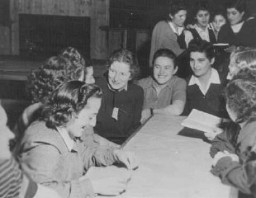
Jewish refugees, part of the Brihah (the postwar mass flight of Jews from eastern Europe), in a crowded boxcar on the way to a displaced persons camp in the American occupation zone. Germany, 1945 or 1946.
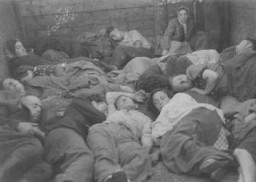
Children in the Bad Reichenhall displaced persons camp. Germany, 1945.
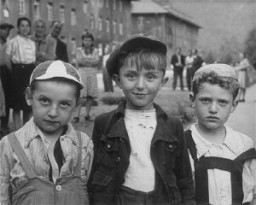
Jewish displaced persons in an ORT (Organization for Rehabilitation through Training) sewing workshop. Landsberg, Germany, between 1945 and 1947.

An ORT (Organization for Rehabilitation through Training) auto mechanics class at Landsberg displaced persons camp. This training prepared the students to emigrate to Palestine. Germany, postwar.
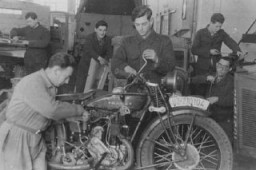
Refugees crowd the rail of the Aliyah Bet ("illegal" immigration) ship Josiah Wedgewood, anchored at the Haifa port. British soldiers transported the passengers to the Athlit internment center. Palestine, June 27, 1946.
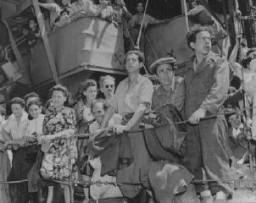
Polish Jewish refugees arriving at Babenhausen displaced persons camp, where the Joint Distribution Committee and the United Nations Relief and Rehabilitation Administration provided aid. Germany, August 20, 1947.
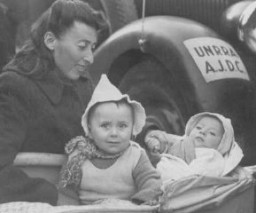
A class for new immigrants in the United States. Postwar.
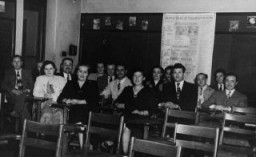
Soldiers from unidentified units of Einsatzgruppe C look through the possessions of Jews massacred at Babi Yar, a ravine near Kiev. Soviet Union, September 29–October 1, 1941.
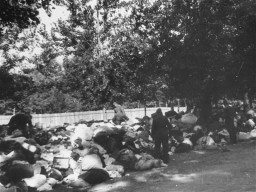
Roundup of the Jews of Lubny, shortly before they were massacred by Einsatzgruppe detachments. This photo, originally in color, was part of a series taken by a German military photographer. Copies from this collection were later used as evidence in war crimes trials. Lubny, Soviet Union, October 16, 1941.
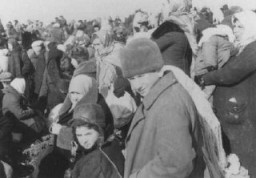
Ukrainian Jews who were forced to undress before they were massacred by Einsatzgruppe detachments. This photo, originally in color, was part of a series taken by a German military photographer. Copies from this collection were later used as evidence in war crimes trials. Lubny, Soviet Union, October 16, 1941.

Site where members of Einsatzgruppe A and Estonian collaborators carried out a mass execution of Jews in September 1941. Kalevi-Liiva, Estonia, after September 1944.
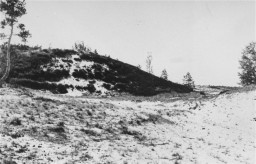
Soon after liberation, a Soviet physician examines Auschwitz camp survivors. Poland, February 18, 1945. This photograph is a still image from Soviet film of the liberation of Auschwitz.

This photograph taken soon after liberation shows young camp survivors from Buchenwald's "Children's Block 66"—a special barracks for children. Germany, after April 11, 1945.
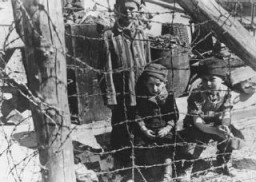
American radio journalists view corpses in the Buchenwald concentration camp. This photograph was taken after the liberation of the camp. Germany, April 18, 1945. Pictured from left to right are, Lowell Thomas (NBC); Howard Barnes (WOR); and George Hamilton Combs (WHN).
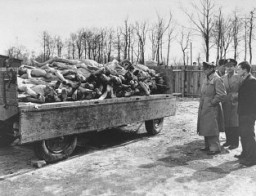
Liberated prisoners demonstrate the overcrowded conditions at the Buchenwald concentration camp. Photograph taken after the liberation of the camp. Buchenwald, Germany, April 23, 1945.
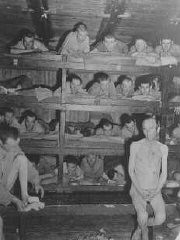
A mass grave at Bergen-Belsen soon after the liberation of the camp. Bergen-Belsen, Germany, May 1945.
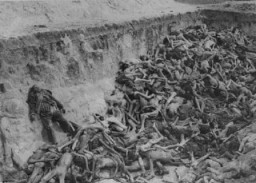
Soon after liberation, camp survivors cook in a field. Bergen-Belsen, Germany, after April 15, 1945. In the days before liberation, the prisoners had been left without food or water. More than 13,000 inmates died in the three months following liberation.
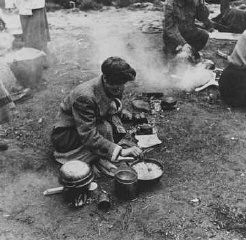
An survivor of the Bergen-Belsen camp, after liberation. Bergen-Belsen, Germany, after April 15, 1945.

US General Dwight D. Eisenhower and General Troy Middleton, commanding general of the XVIII Corps, Third US Army, tour the newly liberated Ohrdruf concentration camp. Ohrdruf, Germany, April 12, 1945.
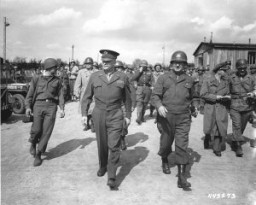
This camera equipment belonged to Walter Hunkler, a sergeant assigned to a medical detachment of the 160th Field Artillery Battalion, which entered Dachau on April 29, 1945. He took photographs documenting the camp and the prisoners found there.
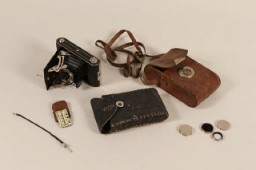
German soldiers in the Soviet Union during a December 1943 Soviet offensive on the eastern front. German troops invaded Soviet territory in June 1941 but faced counteroffensives following the battle of Stalingrad. December 16, 1943.
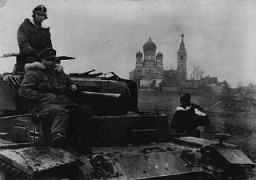
A German army column struggles through the mud, past a destroyed Soviet tank. Nevel, Soviet Union, fall 1943.
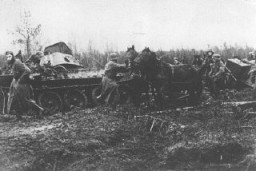
We would like to thank Crown Family Philanthropies, Abe and Ida Cooper Foundation, the Claims Conference, EVZ, and BMF for supporting the ongoing work to create content and resources for the Holocaust Encyclopedia. View the list of donor acknowledgement.